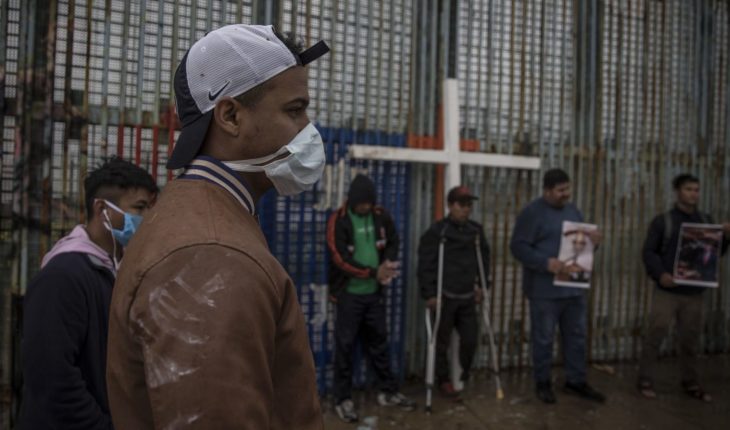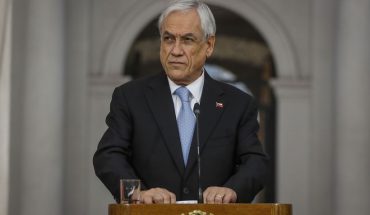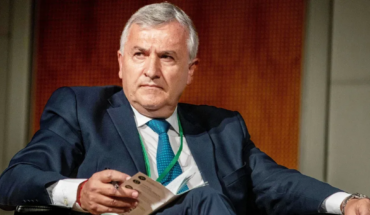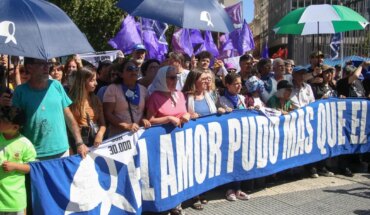Alexander spent his first night in Zacualpa, Quiché, sleeping inside an ambulance. He says he hadn’t bathed for so long that he didn’t even remember the last time he was able to rub it with soap and water. He managed to do so on April 14, 24 hours after landing in Guatemala, when he was transferred to the changing rooms of the municipal stadium, which became the room in which to pass his quarantine.
He had just arrived as a deportee from the United States and had to suffer rejection from his own community. He’s not sick, but he’s suspicious. All those returned from the north may have been infected with coronavirus, of which more than one million contagions have already been detected on U.S. territory.
The young man is not called Alexander, but enough stigma carries behind his back.
Read: 15 migrants in Nuevo Laredo shelter test positive for COVID-19
His eyes are ripped, his skin, toasted, and when talking he has very soft forms. Alejandro is indigenous k’iche’, one of Guatemala’s 23 Mayan ethnic groups, the most marginalized part of one of the most unequal countries in Latin America. He’s 21 years old and he’s been working for almost half his life. This is a demanding land and, since teenagers, boys are already treated like adults at the stroke of cutting sugar cane. Alexander left his back and hands for less than two euros a day. A misery to be shared between him, his wife and his ten-month-old daughter, who barely recognized him on the day he returned to the village.
“I left out of necessity,” says the young man. Here migration is almost an inheritance that passes from parent to child. For this reason, Alejandro left his community, a succession of pauperomas cottages in one of Guatemala’s most impoverished departments. In the Central American country, six out of ten inhabitants are poor. In Quiché, poverty hits 75% of the population and four out of ten people are in dire need.
Alexander’s community is an example of necessity. Here the vast majority are adobe constructions with mud shingles. Anyone who has a little more money, or who receives it in the form of a consignment from the US, can build their cement construction with a sheet roof. Less humble dwellings are no different than elsewhere considered shanty towns, but just look at their facades to find out who succeeded in migrating. There are the houses of the heroes, who painted the bars and stars on the door. They are the ones who dodged the ‘migra’, they overcame a journey in which many left their lives and now support their family with the dollars they earn on the other side of the wall.
Alexander wanted to be one of them, give something better to his family. When he left his home on February 4, it was two weeks before the first case was screened north of Rio Bravo and more than a month for the first Guatemalan infected. Everything changed in his absence. When he returned, on April 13, he was housed in the ambulance because no one wanted to offer him a room. Hunger was no longer the main concern of its neighbors, now so was the virus.
Deported from the US, Alexander had to suffer the rejection of his own community
If Alexander had succeeded, he’d be a hero. But they caught him, turned him around and returned with the stigma of being expelled from one of the world’s largest hotbeds of the pandemic. “The virus is serious, I understand,” he says of his arrival in the community.
The young man landed in Guatemala City without any document proving his health status. He says he passed his quarantine in detention centers in the United States, but local authorities didn’t trust each other. As soon as he set foot in Zacualpa, he was warned that he would have to wait two weeks. He says he had no symptoms and claimed to be well. But, aware of the gravity of the situation, he accepted isolation. He slept one night in the ambulance and then, because they didn’t know where to put it, they found him a space on the football field.
Fear and rumors spread and they nearly sparked a rebellion in the community for using the stadium to care for COVID-19 sufferers. “They told us that if someone got sick it would be our responsibility,” says Dr. Veronica Orozco Escobar, head of the Zacualpa clinic and the person who has taken care of the young man’s health since he arrived in the municipality.
People in Zacualpa are brava. In 2019, police returned after eight years, when discontent spread with the outcome of the municipal elections and some neighbors ended up setting the police station on fire.
Frightened by the presence of someone they considered a focus of infection, they assured that if they were not given explanations, they would repeat their revolt. Neither the curfew decreed by the president, Alejandro Giammattei, caused the neighbors to shelter at home. That night it was tense in the municipality, of just over 20,000 inhabitants and located about 100 kilometers from the capital. Eventually, the neighbors came to their senses and Alexander was able to complete his quarantine and return to his community as a healthy man. He already meets his family and, after being deported for the second time in less than six months, says he will try to get ahead by cutting cane. He says he’s already given up, he won’t try again.
The deportees, under suspicion
The scene in Zacualpa is no exception. In Ixcán, Esquipulas or Quetzaltenango, Guatemalan municipalities with a strong migratory tradition, there are deportees that their neighbors do not accept or organized demonstrations so that they do not pass. People who receive money from remittances or who were even migrants end up forcibly rejecting newcomers, convinced that they can be a focus of contagion. Panic and suspicion have settled in communities, especially during curfew. They have helped in nothing episodes such as that of an expelled man who escaped from the confinement center in Guatemala City and a well-known radio station organized a hunt against the deportee. The search ended with the arrest of an individual he had nothing to do with: a homeless man who was almost lynched.
Read: Judge orders INM to release migrants detained at immigration stations
“When it is announced from the US that people are contaminated, a zozobra situation is generated. There is no due process of medical accompaniment for people who are deported,” says Mauro Verzeletti, director of the Guatemalan City Migrant House. The man, with more than two decades of support for Central Americans fleeing to the United States, believes that exclusion is also a virus and that “discrimination comes from the north,” with the xenophobic rhetoric of Donald Trump and his expulsions without even putting a thermometer on deported people.
The high rate of contagates arriving on deportation flights from the United States led President Giammattei to implement confinement for newcomers. If they tested positive when they landed, they’d be sent to a field hospital. Between April 27 and May 4, the Guatemalan representative suspended air returns, although not those arriving by bus from Mexico. It didn’t last long.
Less flow to the north, more restrictions on those who migrate
Suspicion and rejection of deportees is one of the effects of the virus on migrants, but it is not the only one. The pandemic has blown up the entire immigration system. In Guatemala, Honduras, El Salvador and southern Mexico, flows to the north have declined dramatically. More attention is now paid to those who return obliged than to those who pack.
Omar Alexis is a Honduran from Choloma, one of the most violent municipalities in one of the most violent countries in the world. The 20-year-old was released from the 21st Century immigration station in Tapachula (Chiapas) at one in the early morning of April 11, along with 150 other Central Americans. All the deportees, report, were made to sign a paper. When he wanted to know what it was about, they said, “It’s a 90-day leave, if you keep asking you’ll be locked up.” In the middle of the night, Omar Alexis set out for a walk and did not stop until days later, when he reached the Agua Clara hostel, located 700 kilometers away.
The document is the formula the Mexican government found to empty the migratory stations. They are detention centres for foreigners that could become pockets of contagion. For weeks, NGOs and institutions such as Unhcr had lobbied for migrants to be released. Mexico listened, but opened the doors and told them to look for life. Their commitment to the US is to prevent people like Omar Alexis from reaching the northern border, so he gave them a permit that poses them as asylum seekers but prevents them from being able to travel freely around the country.
Omar Alexis is an example of how the authorities have taken advantage of coronavirus to put in place even more restrictive measures against migrants. From a hostel in Chiapas, the Honduran recounts that he tried to reach the US at the end of March. In fact, he managed to set foot on American soil. He was caught in San Antonio, about 200 kilometers from the border. Previously, those who were intercepted in their situation were detained and prosecuted in detention centres, where they could seek asylum. But Omar Alexis had no choice to defend himself or seek protection. U.S. agents grabbed him and sent him back to Mexico via the Ciudad Acuña international bridge in Coahuila, according to his testimony. There he was greeted by Mexican agents who locked him up in another facility, this time, in his territory. From there he was moved to the 21st century, 41 kilometers from the border with Guatemala, much closer to his home than to the American dream.
Alexander was arrested at a time when the usual rules were still operating and Washington was in charge of getting him home. To Omar Alexis, for the Instead, the Border Patrol expelled him to Mexico and disseunderd him. This is the big change imposed by coronavirus on the border line with the United States.
Read: Migrants vs. COVID-19: Delivered by US, Abandoned in Mexico and bordered closed
As of March 21, Donald Trump announced the closure of his border for non-essential crossings. The president warned that anyone who set foot in the United States and had no documents would be returned to Mexico. The formula is a quick expulsion, without following the usual procedures: the U.S. Border Patrol intercepts migrants, takes them to the nearest international bridge and delivers them to the Mexican National Migration Institute. And Mexico, for the first time, accepts Central Americans as if they were Mexicans, but not to grant them rights, but to take care of their deportation. That is, Guatemalans, Hondurans and Salvadorans who are detained in the United States no longer have to be deported by Washington. Mexican authorities take over.
It happened to Omar Alexis, who suddenly found himself in Tapachula, Chiapas, not knowing what to do. There were thousands in his situation. Until mid-April, at least 10,000. Some were abandoned early in the morning on the border with Guatemala and invited by immigration agents to return across the mountain, as the borders were closed. Others remained overcrowded in immigration stations until Mexico was forced to release them. Some, perhaps the luckiest, were deported by plane or bus.
The deaths of people with coronavirus recorded so far in Guatemala, El Salvador and Honduras do not add up, among the three, nor the death toll that New York has come to account for in one day. However, Washington has curbed its border by ensuring that it is afraid that Central Americans will further increase contagion. And Mexico, in need of agreements with Trump on issues such as oil production, is committed to being the one who sports them.
The limbo of those who cannot advance
The B-side of deportations without control mechanisms are migrants who stayed halfway. Or those waiting at home that the coronavirus of a truce to get going.
It’s not a good time to get on your way north. So believes José Alfredo, a young Honduran who was caught halfway by the pandemic. Actually, it was his third attempt. He tried to get to the United States with the January caravan, but was repelled by the National Guard and returned to his country. He tried again in February, before the border closing. His plan was to reach the north by bike, but he was intercepted when he had pedaled for 170 kilometers. He endorsed the saying of “to the third, goes the vane” and returned to Mexico, but now waits in Comitán, a municipality of Chiapas, for the conditions to improve to return the route to the north. He has found work in a car wash that does not close even for risk of contagion and awaits his chance.
“Now you don’t see anyone en route, I’m going to wait a while for everything to calm down,” he says. José Alfredo is in a strange limbo. Migration is defined by movement and it has been pinned to a location that is not source or destination.
Ramón Márquez, director of La 72, a hostel located in Tenosique, southern Mexico, corroborates this slowness in the flow of migrants. “I’ve never seen it stand like this before,” he says. In his view, fear of the pandemic is the main reason for explaining that the roads are empty. But this doesn’t mean there’s no one trying to cross into America. On May 3, U.S. authorities announced that 21 people had been detained inside a trailer as they crossed the border. The route that has been diminished is that used by the poor among the poor, those who do not have $12,000 to pay a coyote. “Organized crime is still working,” says Mauro Verzeletti.
The motives that push the exodus are maintained. Confinement measures are expected to have catastrophic effects on already collapsed economies such as northern Central America. In Honduras, where six out of ten citizens are poor, there are protests demanding minimal support from families. In Guatemala, white flags proliferate as a symbol of the houses in which you go hungry. In El Salvador, President Nayib Bukele locks up all those who are caught violating the curfew, even if it is a woman who accompanied her son to the latrine because she was so poor that she did not have a bathroom inside her house.
Violence, another epidemic that for now kills more than coronavirus, has not ceased. In Honduras, an average of nine murders a day remain, while in El Salvador there was a bloody weekend with 77 homicides, which broke with the downward trend. If the conditions that motivate the migration don’t change, you just have to wait to see where the flow is reactivated.
The pandemic has shown that there is no closed border when countries want to deport hungry families and victims of crime. The march north has diminished its intensity, but everything points to it being just a parenthesis. With the coronavirus, the exodus has only been quarantined.
* This text was originally published in the “Unprotected” developed by eldiario.es with the collaboration of Oxfam.
What we do in Animal Político requires professional journalists, teamwork, dialogue with readers and something very important: independence. You can help us keep going. Be part of the team.
Subscribe to Animal Político, receive benefits and support free journalism #YoSoyAnimal.
translated from Spanish: A quarantined exodus and rejection of deported migrants
May 9, 2020 |





